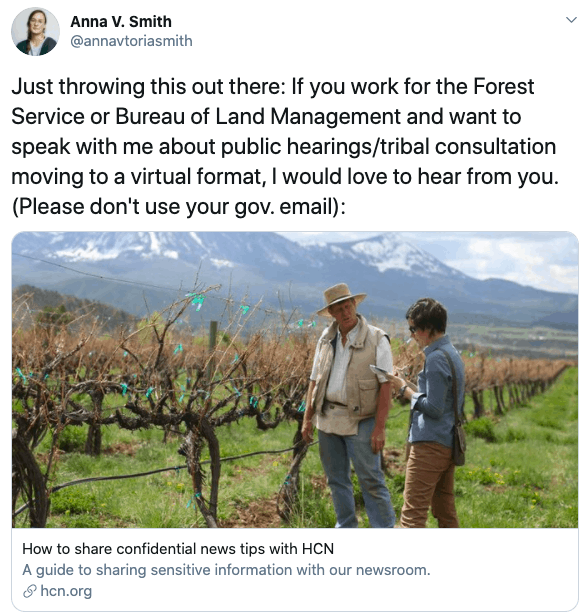The Assistant editor of High Country News’ Indigenous affairs desk, Anna V. Smith, just sent out the following tweet:

If you are a U.S. Forest Service or Bureau of Land Management employee who would like to speak with Smith about public hearings/tribal consultation moving to a virtual format, here’s how you can get in touch with her. Also, here’s the link to the article “How to share confidential news tips with HCN.”
According to this 2018 NPR story “Just over half of Native Americans living on American Indian reservations or other tribal lands with a computer have access to high-speed Internet service, according to new estimates from the U.S. Census Bureau.”
Yesterday, Grist published this story, “Saving Chaco: As coronavirus consumes New Mexico, drilling threatens sacred land.” It included this information:
“Despite their concerns about the prospect of increased drilling, these Navajo communities were largely excluded from the BLM’s virtual public meetings because they either don’t have reliable high-speed internet access or lack it altogether, according to Daniel E. Tso, [who represents eight local government subdivisions, or chapters, within the Navajo Nation Council]. A 2019 Federal Communications Commission report found that less than half of households (46.6 percent) on rural tribal lands have access to fixed broadband service. Beyond the technological hurdles, many residents primarily speak Navajo, so virtual meetings conducted by the BLM in English present an added obstacle.”
This is an important issue.
While I understand the desire of managers to seek efficiencies in times of tight budgets we must still ensure that the processes and policies work for the public.
Indigenous communities are an important part of the public and particularly in some regions of the country. What we now consider as “Public land” was of course indigenous land prior to that. It would be a travesty to adopt public input processes that make it difficult for tribal communities to participate in decision-making.
The agencies probably adhere to the ADA requirements to make their processes accessible for people with hearing and vision challenges.
Similar accommodations need to be made for people who don’t speak English as their primary language and for people who don’t have internet access.
The FS and BLM need to be fair in their efforts to engage our citizens in decision-making.
I agree with the concerns about public meetings and Tribal consultation. It’s also true that many rural areas have poor people without internet and/or bad internet coverage (including where I live).
At the same time, it should be noted that many news sources have suggested that (1) BLM and Forest Service stop working on plans, projects and regulations (for the foreseeable future? until the election?) and (2) it’s not safe for Park Service employees to go back to work in physical space.
Then there’s the old discussion in public involvement circles about the hearing format and the open house format for gathering opinions. Which may be worth of another thread here.
Also, I’d like to point out that that apparently there are Navajo on both sides of the issue, which you might not pick up from the Grist coverage.
https://westernwire.net/navajo-allottees-visit-dc-to-garner-support-for-chaco-canyon-energy-development/
She mentions both public hearings and tribal consultation. There is a lot of law that applies to the latter and it would be rather foolish to not be complying with it in a “meaningful” way. Federal law and policies acknowledge Indian tribes as sovereign nations with inherent powers of self-governance. From this DOI policy paper: https://www.doi.gov/sites/doi.gov/files/migrated/cobell/upload/FINAL-Departmental-tribal-consultation-policy.pdf:
“The obligation for Federal agencies to engage with Indian Tribes on a government-to-government basis is based on the U.S. Constitution and Federal treaties, statutes, executive orders, and policies. Federal agencies help to meet that obligation through meaningful consultation with Indian Tribes.
The Department of the Interior (Department) is committed to fulfilling its Tribal consultation obligations—whether directed by statute or administrative action such as Executive Order (EO) 13175 (Consultation and Coordination with Indian Tribal Governments) or other applicable Secretarial Orders or policies—by adhering to the consultation framework described in this Policy.”
I guess the question would be “can “meaningful” include “not physically in the same room methods?”